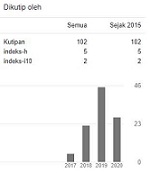THE IMPLEMENTATION OF CLOCK AS MEDIA IN TEACHING GRAMMAR
Abstract
Grammar means a lesson about principles on creating and clustering words into sentences. So that, grammar is very important for people who wants conquering words in English well, because it can guide us to cluster words and sentences correctly. As EFL students almost most of them difficult to mastery English grammar, they found it difficult when they have to use it in their practices. The most difficult part is the verb changing is rather annoying to use. This research aim’s to investigate the implementation of clock as media in teaching grammar in Madura University. It employs a qualitative design. The data of the research were collected through observation, interview and documentation with the descriptive approach. This study focuses on how the clock is applied as a learning media on changes of verbs form, especially irregular verbs. This research was conducted in English Education department of Madura University. Research subjects are students who take Structure class academic Year 2018/2019 Class A. From the data there are 53.3% of students give positive respond toward the implementations of clock as media in teaching grammar especially in changes of verb form. It help them to memorize the irregular verbs.
Keywords
References
Arikunto, Suharsimi. Manajemen pengajaran. Jakarta: Rineka Cipta, 2002
Arsyad, Azhar. 2013. Media Pembelajaran. Jakarta:PT.RajaGrafindo Persada.
Ary, Donald (2002) Introduction to Research in Education. Michigan University: Wadsworth.
Azar, B. S. (1989). Understanding and Using English Grammar, New Jersey: Prentice Hall.
Bachtiar, Prof.Dr.Harsja W. 2010, Media Pendidikan. Jakarta. Rajawali Pers.
Bardovi-Harlig, K. (2000)
Tense and Aspect in Second Language Acquisition: Form Meaning and Use. Oxford: Blackwell Bogdan, T. (2000).
Introduction to Qualitative Methods. Wiley Book: An ESL/EFL Teachers' Course. Boston: Heinle and Heinle.
Butterfield, Jeremy. 2008.
Damp Squid: The English Language Laid Bare, Oxford University Press, Oxford. 978-0-19-923906
Celce-Murcia, M.; Larsen-Freeman, D. & Williams, H. A. (1999). The grammar
Cipolla, Carlo M. (2004)
Clocks and Culture, 1300 to 1700. W.W. Norton & Co. ISBN 0-393-32443-5., p.31
Cowan, R. (2008). The Teacher's Grammar of English. Cambridge: Cambridge University Pres
Dohrn-van Rossum, Gerhar (1997). History of the Hour: Clocks and Modern Temporal Orders. Univ. of Chicago Press. p. 121. ISBN 0-226-15510-2.
Geoffrey, David & Festinger (2005) Essential 0f Resesearch Design and Methodology.
Willey Harmer, J. (1989). Teaching and Learning Grammar, London: Longman.
Sadiman, S. Arief et al. 2007. Media Pendidikan.Jakarta:PT.RajaGrafindoPersada
Salaberry, R. & Shirai. Y. (2002). The L2 Acquisition of Tense-Aspect Morphology. Amsterdam: Benjamins
Yuliarsih. (2016). The Effectiveness of Using Picture Series to Teach Writing in SMPN 1 Waru Pamekasan. Kabilah. Journal of Social CommunitVol.1. ISSN: 2502-9649.35-47
DOI: 10.53712/ellite.v2i1.754
Refbacks
- There are currently no refbacks.







